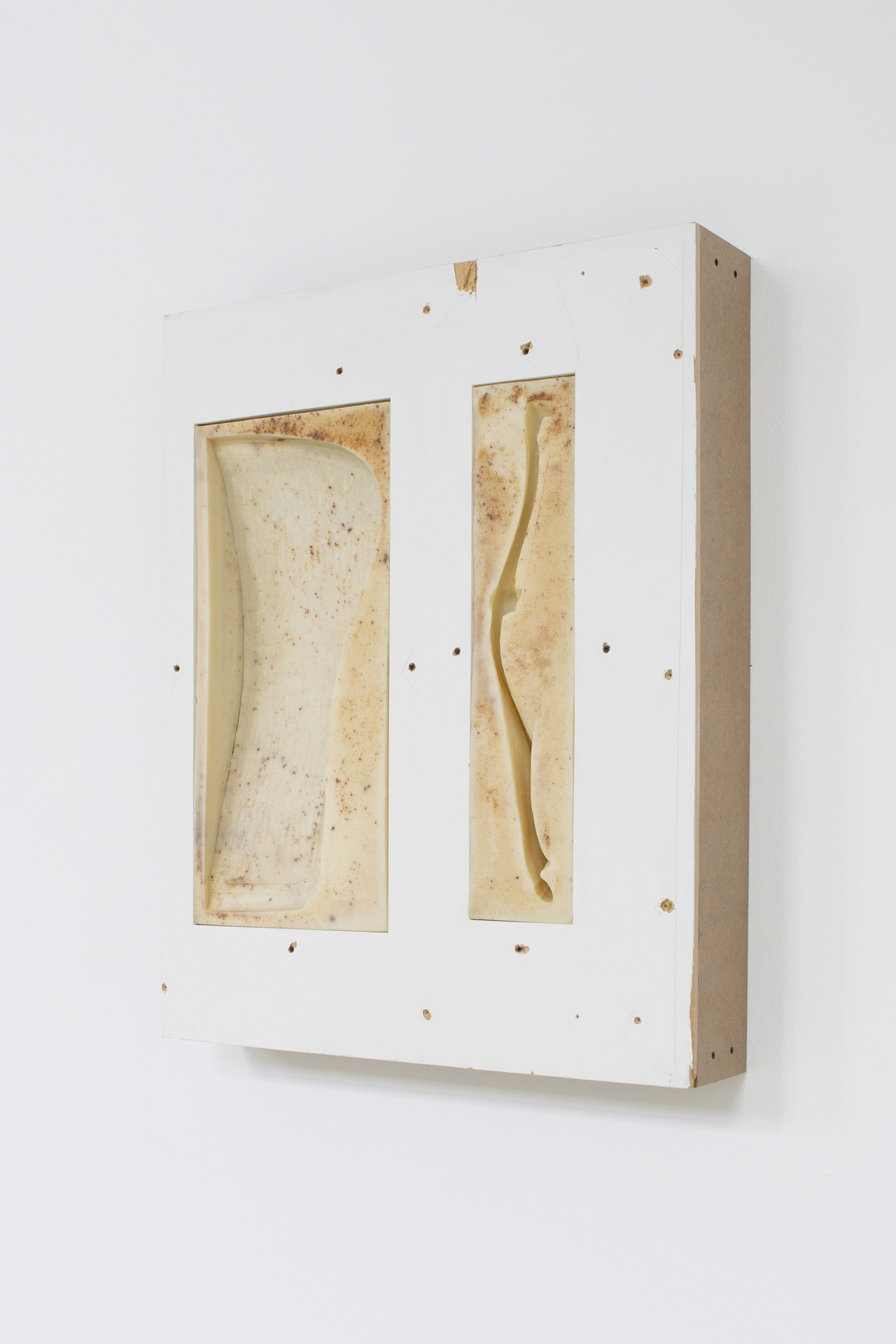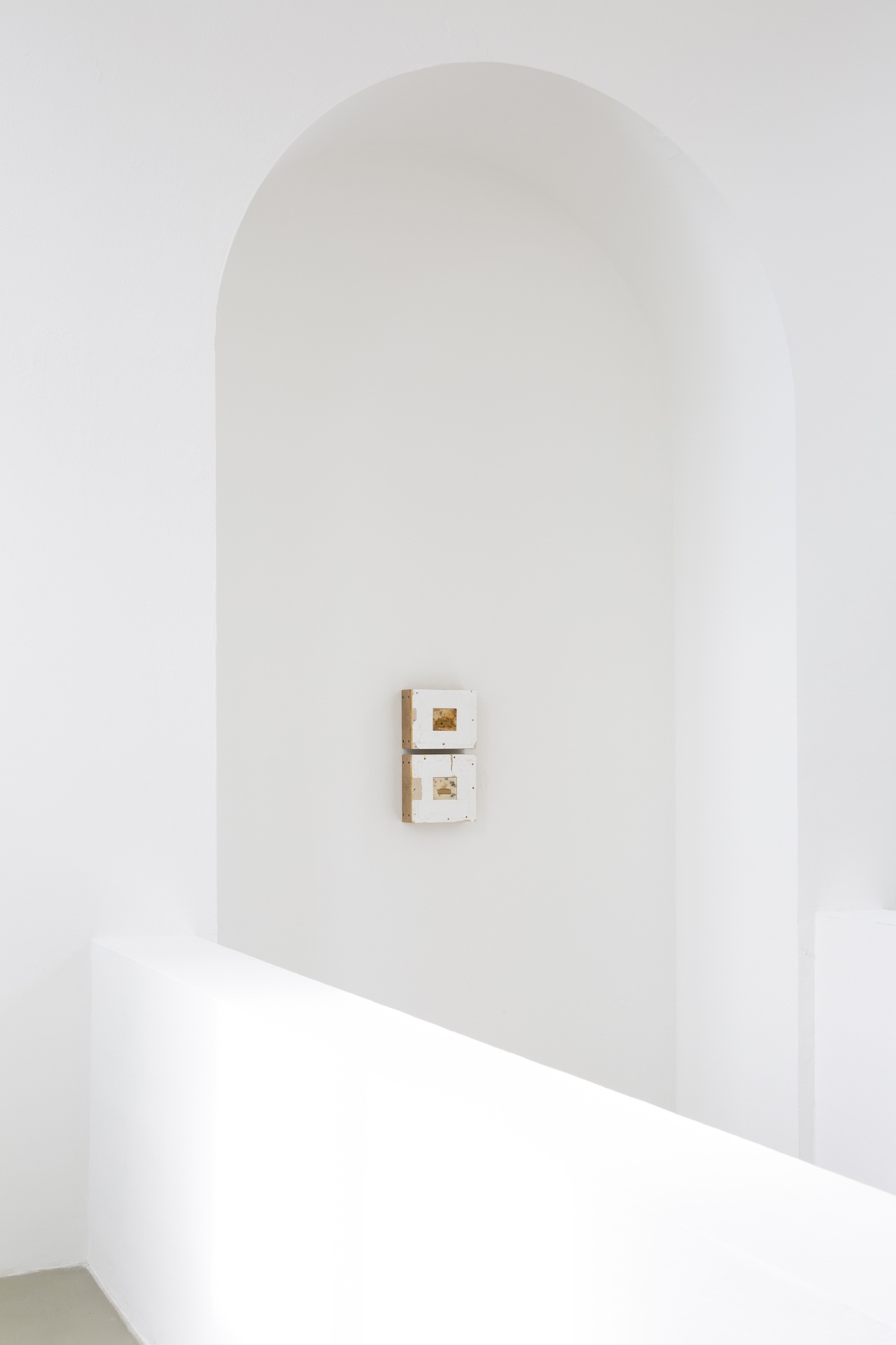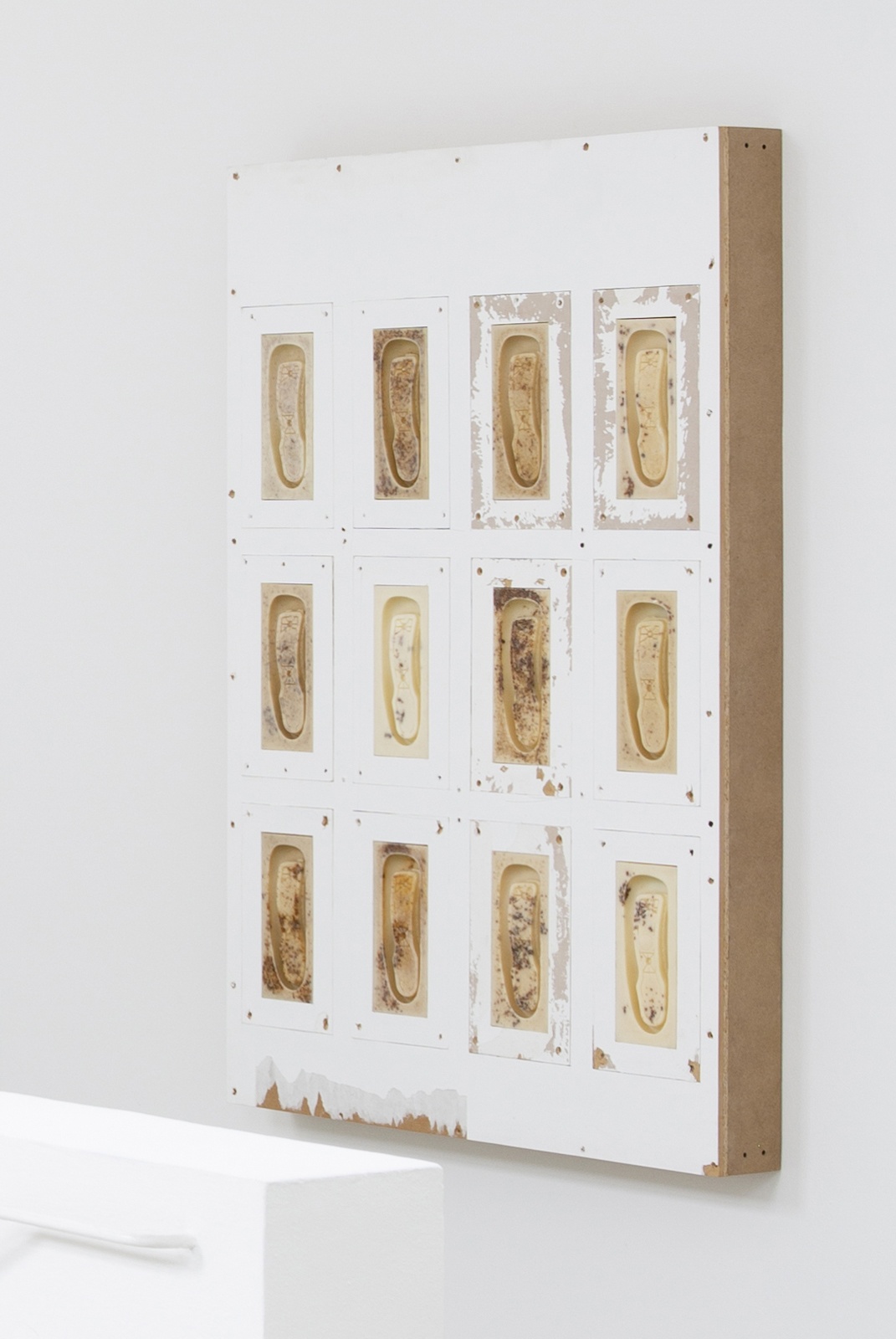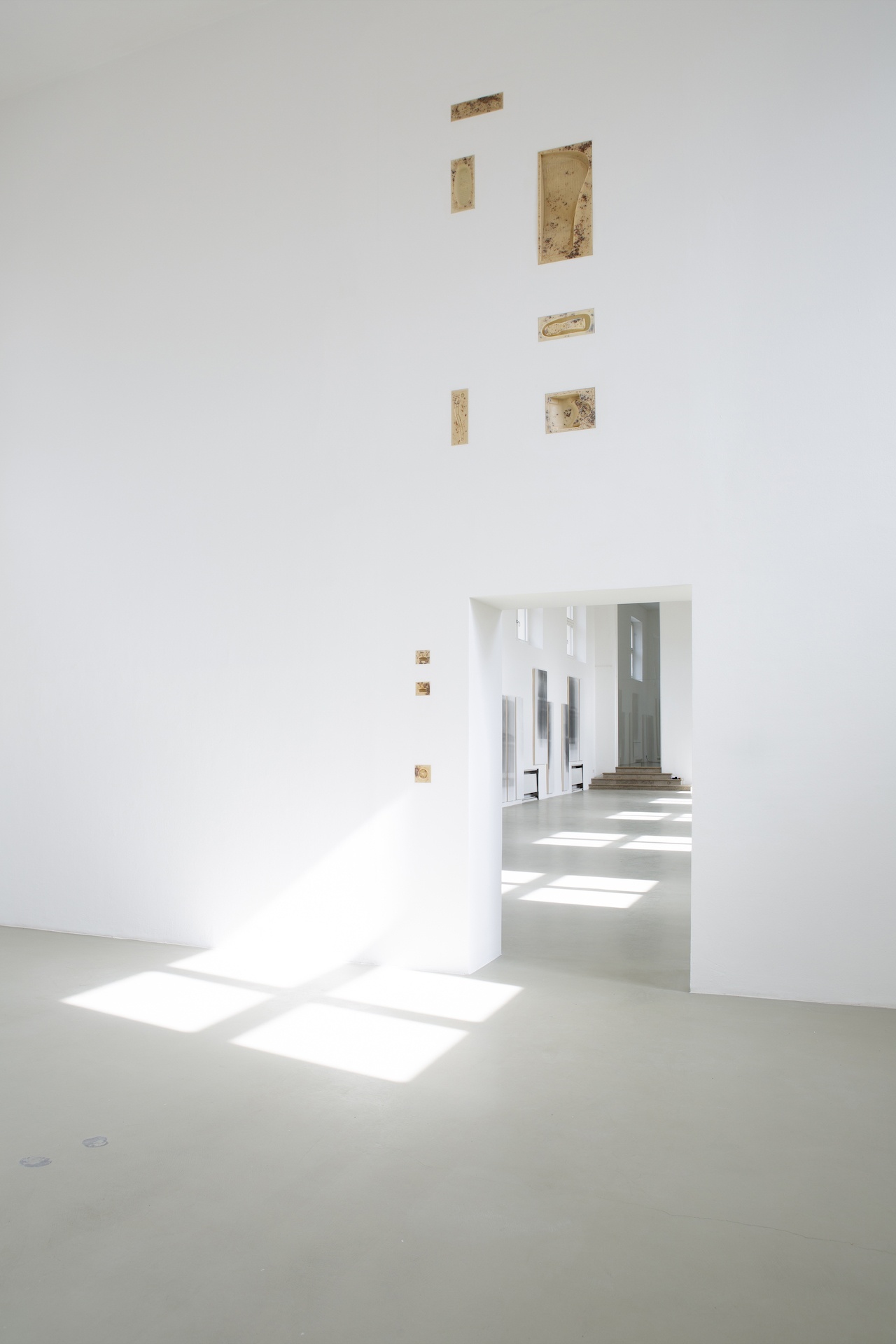HUSH, HOLD by Quinn Latimer

“Patricia L. Boyd: Hold,” Kunstverein München, March 9–May 9, 2021, installation view
Hush, you might say to yourself. Or: Hold. You are not writing a poem; you are holding on. One week lakeside in Bavaria and you are already talking to yourself or to the walls. The walls in the city seem to be holding, so you take the train in, away from the mountains, to see some exhibitions for the first time in six months. The institutions have opened but another wave is cresting and they will likely close, as they have across the borders, so better see the shows fast. You’ve gotten out of the habit of seeing art, letting it do its quick work on you. Art has been one of your forms of self-soothing, as the scriptwriters say, since you were a child: close enough to the wall holding the painting or some sculptural object or some still or moving images, and your mind goes quiet, your posture relaxes into the only body that would appear to hold you, your mouth mouths: Hush. Then:* Hold.*
You take it in. Your porosity, some seriousness of breathable purpose, invites the wall and its object into a kind of loop or short circuit of physicality and mutuality and reception that allows you to – what – hold on. You take what is there – you always have. The art is a gift, or it is a grift, but either way you are grateful; in this relation, you are always in debt. You figured out this trick when you were a kid and you’ve been doing it since. Now that art isn’t enough, though (and, anyhow, the art spaces open and close like a short circuit now), you do other things – coaxing the same chemicals, with your thirsty circuits, to release. You run, yes, but running isn’t enough; there are other tricks. Love is one; friendship, another; reading and writing, of course, too; but it’s all in doubt these days. You can barely read; your attention is shot. Your life has narrowed and emptied and loosed you again, in a way you did not foresee, and you are always in sorrow, desire: Hush. You beg: Hold. And something does.
A language not on its knees to meaning. This is a line that crops up frequently in your texts this past year. Why? It is not difficult to deduce the reasons for this image of supplication to the sonorous text, to the visual and acoustic languages beholding your life, to your own prodigious grief, to your own stuttering desire. If the language is not on its knees to meaning, what is it on its knees for. Is this supplication or sound or sorrow and is there a difference. Is this about the cold stone floor of the sentence? For instance: You have spent the past weeks writing about a Black conceptual poet of sixties New York whose two out-of-print books have been reissued by an art world suddenly awake to its own not casual operations of white supremacy. The late poet’s poems – semiotic, material, improvisatory, incandescent, concrete – are not on their knees to meaning, no, but they are studded with desire: so many Os, that lick of lyric poetry, orgasmic sign of the oral, so much code studding his pages.

“Patricia L. Boyd: Hold,” Kunstverein München, March 9–May 9, 2021, installation view
DOOOOOOOOOOOOOOOOOOOM, one poem of his goes and you echo, with the despondent satisfaction of the disciple, with a long outbreath of circulating air. [1] It’s a long viral note and you blow it. The poet’s name is N. H. Pritchard and you study his portrait. The image bleeds to the very edges of his book cover in the way of late-century publishing, in the very way that you like. One’s image stayed at the very surface of one’s work, flooding it. On his cover, Pritchard’s mustache is curled, his tie is wide, his eyes soft. Inside, his poems syncopate the pages, his grounds, his walls; studded with space, with lacunae, with some poetics of absence, the poet’s lines hum with ambient structure. His book is called The Matrix. A matrix is a structure; it holds.
In the city, the institution that has brought you to this northern country has an exhibition that also holds. It is called, well, “Hold.” [2] In the tall, narrow, cathedral-like space of Kunstverein München, the walls are embedded with blocks of soap-like material both hard and soft, forms of illumined opacity. A milky amber hue of light and grease and burned, burnished fields, the forms seem specked with spores, but it is cooking grease gleaned from restaurants; they are negative casts of various forgotten objects – tools, screws, the arm of an office chair – whose absence they hold within them, then offer you. The empty space they carve is so articulate that you read it like signs, like code, like language. The soap-like casts are embedded in recesses cut into new holding walls of the institution, or they are held by thick frames of the flaking white walls of the previous art institutions in which they had been previously installed, and which the artist sliced into when the exhibition was done, extracting the surrounding section of wall. Thus does the excised wall become permanently attached to the cast, less a frame than a containing body. The artist, Patricia L. Boyd, describes these excisions as prostheses; their function is to hold the cast and to extend it – in size, in meaning, in citation, in circulation.
High up on the wall, or placed at eye level, Boyd’s works appear to you like votives, like icons, like screens, like memory, like fragments of celestial or corporeal bodies. Image and sculpture, sign and signified, the works immediately “touch” you, “speak” to you, extend their “hand,” as it were, both soft and hard, to you. (If you will continue to go to the body for your metaphors, it is because this is what holds you. Here and elsewhere.) The “wall pieces” seem to offer glimmers of some self-blazoning, as did the medieval women mystics. Still, you stare at the rough white frames of wall containing their cast centers. The structural dependency they make manifest, the institutional and psychic conditions they embody, the care they make rough and sly. You wonder about the long-left fragments and past conditions that you carry about your person. About the previous lives and institutional relations and departed loves that frame you like some roughly excised set of walls; about the absent objects that you yourself contain the sign of.

“Patricia L. Boyd: Hold,” Kunstverein München, March 9–May 9, 2021, installation view
What of object relation theory, of all this living relative to objects? Internal objects refer to the internalization of external objects, formed from our early dependencies on our parents – or so (you think) suggests D. W. Winnicott’s theory of holding. This theory, everywhere at the moment – and what does this say, hold for us, what water does it carry – is about the psychic work that being held, cared for, dependent, does. Or does not do if such care is withheld. Winnicott once wrote about a session in which a patient described, with his hands, being curled up, suggesting, as the doctor put it, like some art historian-cum-psychic: “the existence of a medium.” Winnicott went on: “After a while I asked him if he understood what I meant and I found that he had immediately understood; he said, ‘Like the oil in which wheels move.’ Having now received the idea of the medium holding him, he went on to describe in words what he had shown with his hands.” [3]
Carrying these thoughts with you (not in your hands, though), you move to the next room. Slanted with light from the line of windows set high in the walls, the room holds a series of large photograms of the artist’s apartment windows. Windows above, then, and windows below; images all. Exposed and brushed by trees and sky and everything else it does or does not contain. Negative light: images of what was and what left an indelible impression. You feel the high, wide, narrow walls of the Kunstverein München press in. You feel exposed or held – you cannot tell. Situated along the arcades of the Hofgarten, the Kunstverein’s building once served as an insulated passageway between courtly venues. Later these rooms held the Museum für Abgüsse Klassischer Bildwerke, that is, the Museum of Casts of Classical Sculpture. The high windows and broad walls ape the interiors of 18th-century picture galleries, which needed the wall space and light to – what – hold what they displayed.
You check your phone: among your messages is an announcement of another exhibition at another institution, Bonner Kunstverein, in which some echo, some rhyme, catches your eye. It is a group show called “The Holding Environment.” Your read the description quickly: “The notion of the holding environment – the slippage between care, dependence, holding and that which fails to hold adequately – loops back in the show,” which engages “with the pitfalls of a corrupted notion of care, but also with paths for rehabilitation, restoration and restitution, negotiated through a non-selfish spirit of holding.” [4] It is the season of theorizing care, you know this; you have just moderated a symposium on this. It is the season of pandemic and systems which will not hold you, will hold no body carefully but capital. Still, the voluminous use and array of these C and R and H words impresses you (they impress and they hurt you). You wonder if you might take the train to Bonn, if the new regulations will allow it.

“Patricia L. Boyd: Hold,” Kunstverein München, March 9–May 9, 2021, installation view
There are other places of holding to visit, too, though—to behold. The Hölderlinturm is one. The tower in Tübingen that held Hölderlin from 1806 until the poet’s death in 1843. The poet who never left the grief of his childhood, his mother who never visited him within his holding tower. The tower’s foundation goes back to the 13th century, its stone gleaned from the medieval city wall that once traced the northern bank of the Neckar. Hölderlin – an ancestral Höld, if you will – once wrote: “Who reigns over everything wants most / Is that the established Word be / Caringly attended, and that / Which endures be construed well.” [5] You slip (as if on a stone) and read “constructed well” and imagine a wall, running along a river, and then its disassembling, its pale stones taken and slotted for a foundation for a tower, shot through with light and dark and dependency and poetry, rising above that same gleaming water.
There are other poems. Other walls both ancient and nascent, their seasons of holding and containing, their self-soothing or shattering songs in the key of H. What is that Lydia Davis poem? You think it’s called Hush, Hold but you know it’s really called “Head, Heart.” What if it weren’t, though. What if it were a simple equation in which one could swap certain words for other signs of H and ache? Here we go:
Hush, Holdby Lydia DavisHold weeps.Hush tries to help Hold.Hush tells hold how it is, again:You will lose the ones you love. They will all go. Buteven the earth will go, someday.Hold feels better, then.But the words of hush do not remain long in the ears of hold.Hold is so new to this.I want them back, says hold.Hush is all hold has.Help, hush. Help hold. [6]
You’d do to read the real poem now. No, really. You’d do to hush, to hold, to stop reading doom and dependency in every surface and sign, its lick and lock of departing love, deserting desire, desert where your family should be. On and on and on. So go back to the lake. Open the book. Approach the object, the image, the wall. Let it hold you. Let it hush you in its expert relation, if just for a bit. You are in so much debt. Getting close won’t hurt a bit.
Quinn Latimer is the author of Like a Woman: Essays, Readings, Poems (Sternberg Press, 2017). She was editor-in-chief of publications for documenta 14 in Athens and Kassel, and she is currently a lecturer at Institut Kunst in Basel.
Image credit: courtesy of Patricia L. Boyd and Kunstverein München, photos: Constanza Meléndez
Notes
| [1] | N.H. Pritchard, The Matrix Poems: 1960–1970 (Brooklyn, NY: Primary Information, 2021). |
| [2] | “Patricia L. Boyd: Hold,” curated by Gloria Hasnay, at Kunstverein München, March 9–May 9, 2021. |
| [3] | D.W. Winnicott, Holding and Interpretation: Fragment of an Analysis (London: Hogarth Press, 1986), 188. |
| [4] | “The Holding Environment,” curated by Fatima Hellberg, opens at Bonner Kunstverein on April 9, 2021. |
| [5] | Friedrich Hölderlin, “Patmos,” translated by Scott Horton. In Harper’s Magazine, July 16, 2007, https://harpers.org/2007/07/patmos/. |
| [6] | With apologies and debt to Ms. Davis for using her poem like this. The reader can find her original, “Head, Heart,” in The Collected Stories of Lydia Davis (New York: Picador, 2010). |
